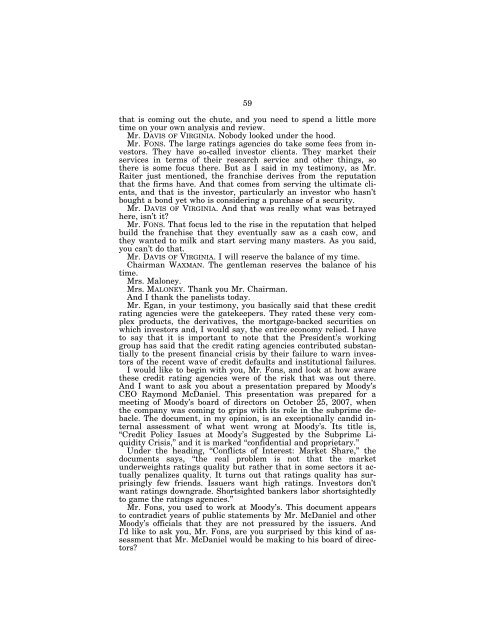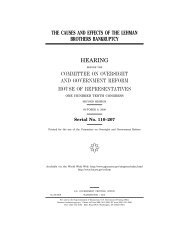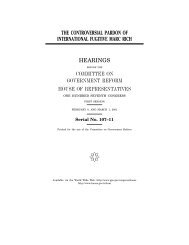CREDIT RATING AGENCIES AND THE FINANCIAL CRISIS ...
CREDIT RATING AGENCIES AND THE FINANCIAL CRISIS ...
CREDIT RATING AGENCIES AND THE FINANCIAL CRISIS ...
- No tags were found...
You also want an ePaper? Increase the reach of your titles
YUMPU automatically turns print PDFs into web optimized ePapers that Google loves.
59that is coming out the chute, and you need to spend a little moretime on your own analysis and review.Mr. DAVIS OF VIRGINIA. Nobody looked under the hood.Mr. FONS. The large ratings agencies do take some fees from investors.They have so-called investor clients. They market theirservices in terms of their research service and other things, sothere is some focus there. But as I said in my testimony, as Mr.Raiter just mentioned, the franchise derives from the reputationthat the firms have. And that comes from serving the ultimate clients,and that is the investor, particularly an investor who hasn’tbought a bond yet who is considering a purchase of a security.Mr. DAVIS OF VIRGINIA. And that was really what was betrayedhere, isn’t it?Mr. FONS. That focus led to the rise in the reputation that helpedbuild the franchise that they eventually saw as a cash cow, andthey wanted to milk and start serving many masters. As you said,you can’t do that.Mr. DAVIS OF VIRGINIA. I will reserve the balance of my time.Chairman WAXMAN. The gentleman reserves the balance of histime.Mrs. Maloney.Mrs. MALONEY. Thank you Mr. Chairman.And I thank the panelists today.Mr. Egan, in your testimony, you basically said that these creditrating agencies were the gatekeepers. They rated these very complexproducts, the derivatives, the mortgage-backed securities onwhich investors and, I would say, the entire economy relied. I haveto say that it is important to note that the President’s workinggroup has said that the credit rating agencies contributed substantiallyto the present financial crisis by their failure to warn investorsof the recent wave of credit defaults and institutional failures.I would like to begin with you, Mr. Fons, and look at how awarethese credit rating agencies were of the risk that was out there.And I want to ask you about a presentation prepared by Moody’sCEO Raymond McDaniel. This presentation was prepared for ameeting of Moody’s board of directors on October 25, 2007, whenthe company was coming to grips with its role in the subprime debacle.The document, in my opinion, is an exceptionally candid internalassessment of what went wrong at Moody’s. Its title is,‘‘Credit Policy Issues at Moody’s Suggested by the Subprime LiquidityCrisis,’’ and it is marked ‘‘confidential and proprietary.’’Under the heading, ‘‘Conflicts of Interest: Market Share,’’ thedocuments says, ‘‘the real problem is not that the marketunderweights ratings quality but rather that in some sectors it actuallypenalizes quality. It turns out that ratings quality has surprisinglyfew friends. Issuers want high ratings. Investors don’twant ratings downgrade. Shortsighted bankers labor shortsightedlyto game the ratings agencies.’’Mr. Fons, you used to work at Moody’s. This document appearsto contradict years of public statements by Mr. McDaniel and otherMoody’s officials that they are not pressured by the issuers. AndI’d like to ask you, Mr. Fons, are you surprised by this kind of assessmentthat Mr. McDaniel would be making to his board of directors?VerDate 11-MAY-2000 12:35 Aug 24, 2009 Jkt 000000 PO 00000 Frm 00063 Fmt 6633 Sfmt 6633 U:\DOCS\51103.TXT KATIE PsN: KATIE








